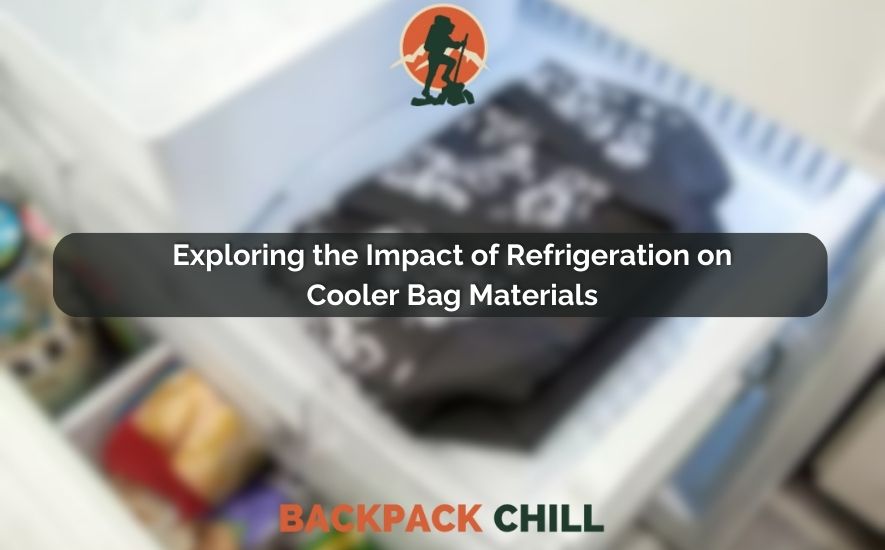Physical Address
304 North Cardinal St.
Dorchester Center, MA 02124

Have you ever wondered if it’s safe to stash your trusty cooler bag in the fridge to keep your beverages and snacks extra chilled? It’s a common question that might arise when you’re looking to prolong the freshness of your goodies or simply looking to enjoy a refreshing cool drink on a scorching day.
Can You Put A Cooler Bag In The Fridge? Yes, you can put a cooler bag in the fridge! While cooler bags are primarily designed to insulate and maintain the cold temperature of their contents, placing them in the fridge can actually enhance their performance.
In this article, we will explore whether placing your cooler bag in the fridge is a viable option, considering the impact it may have on the contents inside and the overall efficacy of your cooling efforts. Let’s dive in and uncover the best practices to ensure your snacks and drinks stay fresh and delightful.
One of the most significant benefits of using a cooler bag in the fridge is the extension of food shelf life. The insulation provided by the cooler bag helps maintain a consistently low temperature, preventing the fluctuation that can occur when the refrigerator door is frequently opened.
By storing perishable items like dairy products, meat, and vegetables in the cooler bag, you create a stable microenvironment, inhibiting bacterial growth and spoilage. This ensures that your food stays fresh for a more extended period, reducing food waste and saving you money.
Optimizing energy efficiency is crucial in today’s eco-conscious world, and a cooler bag can help achieve this within your fridge. When you open the refrigerator door, cold air escapes, and the appliance works harder to maintain the set temperature.
However, with a cooler bag, you can organize your food items efficiently, allowing you to retrieve what you need quickly. As a result, you minimize the frequency and duration of door openings, reducing energy consumption and contributing to a greener, more sustainable lifestyle.
Keeping your fridge organized can be a challenging task, especially with various food items jostling for space. Using a cooler bag in the fridge helps streamline the organization process.
By categorizing your groceries and storing them in separate bags, you can easily locate and access items without rummaging through the entire refrigerator. This promotes a clutter-free environment, reduces the chances of forgotten or expired food items, and ultimately saves you time during meal preparation.
A cooler bag’s inherent portability makes it perfect for on-the-go individuals or families. Not limited to outdoor activities, you can transfer the cooler bag directly from the fridge to a picnic, work, or a day trip.
Pre-packed with chilled and organized food items, it simplifies the packing process and ensures you have a ready-to-go, fresh, and nourishing meal wherever you are. Furthermore, the reusable nature of cooler bags reduces the reliance on single-use plastic bags, contributing to a more environmentally friendly lifestyle.
Apart from its functional benefits, using a cooler bag in the fridge can enhance the overall aesthetic and cleanliness of the appliance. By neatly organizing your groceries in individual bags, spills and leaks are contained within the cooler bag rather than spreading across the refrigerator shelves.
This reduces the risk of cross-contamination and minimizes the need for frequent cleaning. Additionally, the visually appealing and tidy appearance of the cooler bag adds a touch of elegance to your fridge, making it a delight to open and use.

Before placing your cooler bag in the fridge, always ensure it is clean and completely dry. Cleaning the cooler bag with mild soap and water after each use prevents the growth of bacteria and avoids any lingering odors.
Thoroughly dry the bag by air-drying it in a well-ventilated area or using a clean towel. A dry and clean cooler bag is essential to maintain the freshness of the items you store inside.
To maximize the cooling efficiency of your cooler bag, consider freezing reusable ice packs beforehand. Placing pre-frozen ice packs inside the cooler bag will keep the contents cold for an extended period without the risk of melting ice leaking and creating a mess. This also helps in conserving energy as the fridge will not need to work as hard to cool down the warmer ice packs.
When storing the cooler bag in the fridge, organize its contents strategically. Ensure that perishable items like dairy products, meats, and cooked foods are stored towards the back of the fridge where the temperature is colder.
Place beverages, fruits, and other non-perishables towards the front or on the fridge door. This arrangement helps maintain a consistent temperature throughout the cooler bag and fridge while preventing cross-contamination between perishables and non-perishables.
Resist the temptation to overstuff the cooler bag when placing it in the fridge. Overcrowding the bag can hinder proper airflow, reducing the cooling efficiency and potentially leading to uneven temperature distribution. Leaving some space inside the cooler bag allows the chilled air to circulate effectively, keeping all the items inside at the desired temperature.
To ensure that your cooler bag’s contents remain fresh, make it a habit to check the items regularly. Dispose of any expired or spoiled food promptly. Additionally, rotate the items inside the cooler bag to use the oldest ones first. By doing so, you can prevent food waste and always enjoy the freshest items from your cooler bag.

One of the primary functions of cooler bags is their ability to provide thermal insulation. Various materials, such as foam, polyester, and aluminum, are commonly used to create layers of insulation within the bag.
When exposed to refrigeration, these materials experience temperature fluctuations and stress, which can affect their insulation capabilities. Understanding the thermal behavior of different materials is vital in selecting those that remain resilient and maintain optimal insulation even after repeated exposure to refrigeration.
Cooler bags often encounter various environmental conditions during their usage, including exposure to freezing temperatures in refrigerators. The materials used in cooler bags must retain their flexibility and durability to withstand temperature changes without cracking or losing structural integrity.
Rigidity can lead to discomfort for users and may cause damage to the bag, compromising its insulating properties. Hence, exploring materials that offer a balance of flexibility and durability under refrigeration is crucial for long-lasting cooler bags.
Refrigeration can lead to condensation inside the cooler bag, primarily when there is a significant difference between the internal and external temperatures.
The cooler bag materials must exhibit moisture resistance to prevent the growth of mold, mildew, and other microorganisms that could spoil the stored goods or affect the bag’s hygiene. Evaluating how different materials handle condensation and moisture build-up is essential in creating effective cooler bags that keep their contents fresh and safe.
As the world emphasizes sustainability and eco-friendliness, evaluating the environmental impact of cooler bag materials becomes crucial. Some materials may release harmful substances or contribute to pollution during refrigeration or disposal.
Manufacturers need to prioritize eco-friendly materials that not only perform well under refrigeration but also minimize their ecological footprint. This would not only benefit the environment but also enhance the reputation of the cooler bag brands in the eyes of environmentally-conscious consumers.
Thermal conductivity refers to a material’s ability to transfer heat. In the context of cooler bags, it is essential to consider how materials with different thermal conductivities perform under refrigeration. Low thermal conductivity helps keep the bag’s contents cold by reducing heat transfer from the external environment.
A thorough analysis of thermal conductivity in cooler bag materials can lead to more efficient designs that keep perishable items fresh for longer periods, making them ideal for extended trips or outdoor activities.
In conclusion, while it may seem counterintuitive to some, placing a cooler bag in the fridge is indeed a practical and efficient way to maintain the freshness of its contents. The insulating properties of the cooler bag help regulate the internal temperature, preventing rapid temperature fluctuations that can occur in traditional containers.
This method can be especially useful when storing perishable items during outdoor excursions or picnics. However, it’s essential to ensure that the cooler bag is clean and dry before refrigeration to avoid any bacterial growth. By doing so, we can prolong the shelf life of our food and reduce unnecessary waste, making our cooling experience more eco-friendly and enjoyable. Happy chilling!
Certainly! Placing your cooler bag in the fridge is perfectly fine. In fact, it can be quite beneficial, especially when you want to cool the contents inside the bag further. The insulated material of the cooler bag helps maintain the cold temperature, preventing the contents from spoiling quickly.
Absolutely! Your insulated bag is designed to retain both cold and hot temperatures effectively. So, popping it in the fridge is a fantastic idea if you want to keep perishables cold for a longer time. Before placing it in the fridge, empty out any leftovers or spills and wipe the bag clean.
While putting your cooler bag in the freezer might seem like a good idea, it’s not recommended. The insulated material of the cooler bag is not designed to handle the extreme cold of the freezer, and it may lead to damage.
Instead, for optimal results, focus on using ice packs or frozen gel packs within your cooler bag to keep items cold. This way, you can enjoy the benefits of a well-chilled bag without risking any harm to its material.
Chilling your cooler bag is simple and effective! First, empty out any remaining items and clean the bag with mild soap and water. Once dry, place ice packs or frozen gel packs inside the bag, distributing them evenly for maximum coverage. You can also toss in some ice cubes if you like.
Close the bag securely, and then store it in the refrigerator for a few hours or overnight. This method allows the cooler bag to cool down efficiently, making it ready to keep your drinks and snacks refreshingly cold when you need them.